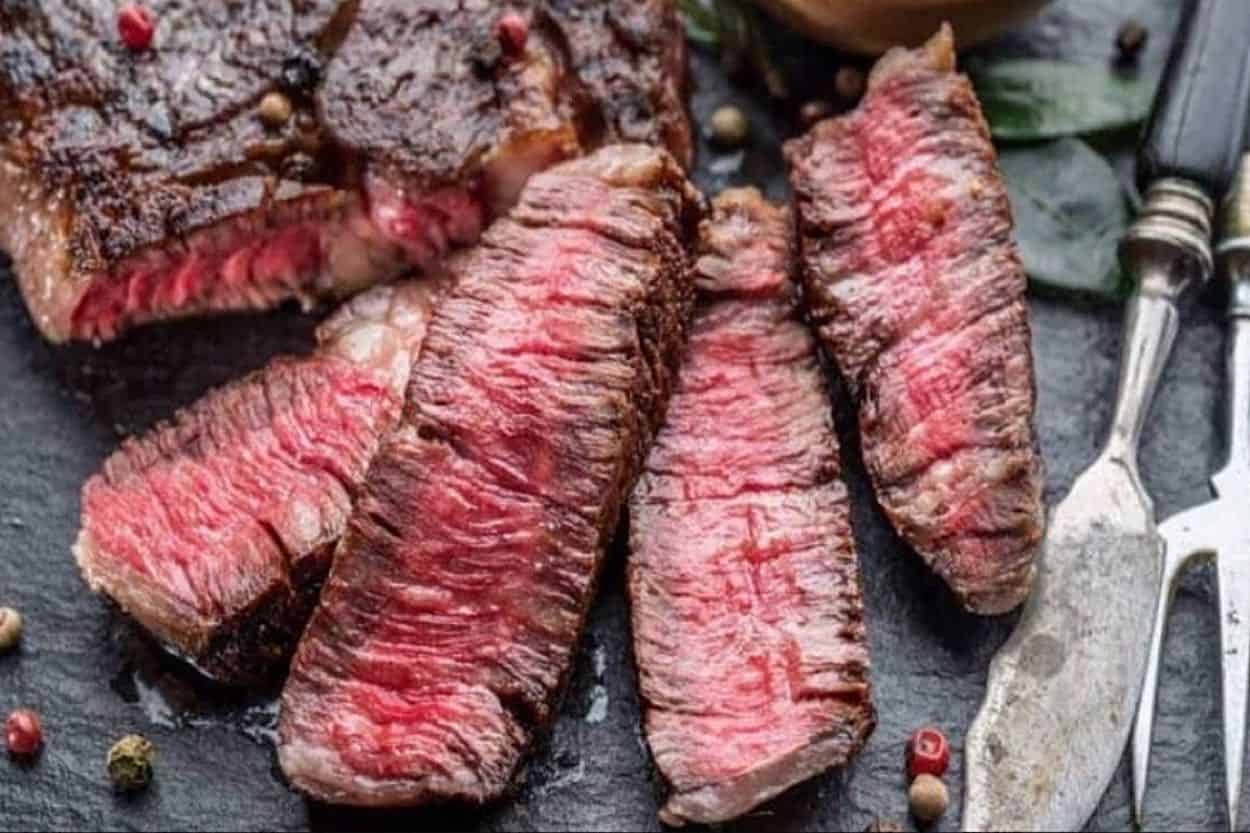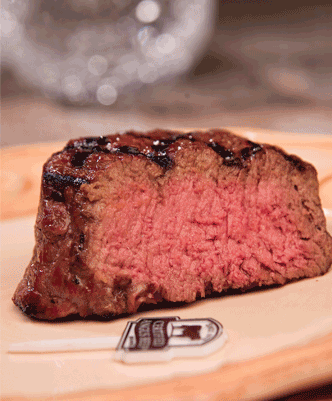Mastering The Medium Rare Beef Temp: Your Guide To Perfect Steaks
For many culinary enthusiasts and home cooks alike, the quest for the perfect steak culminates in one ideal: a beautifully cooked piece of beef with a warm, red center. This coveted state is known as medium rare, and achieving the precise medium rare beef temp is the secret to unlocking unparalleled flavor and tenderness. It’s a balance that transforms a simple cut of meat into a truly memorable dining experience, making it the most sought-after doneness level in kitchens and restaurants worldwide.
While the allure of a perfectly seared exterior giving way to a succulent, juicy interior is undeniable, hitting that sweet spot requires more than just guesswork. It demands precision, understanding, and the right tools. This comprehensive guide will walk you through everything you need to know about cooking beef to a flawless medium rare, ensuring every bite is as delicious as you envision.
Table of Contents
- The Allure of Medium Rare: Why It's the Gold Standard
- Demystifying the Medium Rare Beef Temp: What Numbers to Aim For
- The Critical Role of Your Thermometer: Precision for Perfection
- The Science of Carryover Cooking: Don't Overlook the Rest
- Medium Rare for Different Cuts: Steak vs. Roast Beef
- A Comprehensive Guide to Beef Doneness Levels
- Troubleshooting and Tips for Consistent Medium Rare Beef Temp
- Conclusion: Embrace the Medium Rare Masterpiece
The Allure of Medium Rare: Why It's the Gold Standard
When discussing steak doneness, the phrase "medium rare" often emerges as the reigning champion. It’s not just a preference; for many, it’s the definitive way to enjoy beef. The temperature of beef medium rare is, without a doubt, the most popular internal temperature, closely followed by medium. This isn't by chance. Medium rare is how it’s usually served in restaurants, unless you specifically request otherwise, a testament to its widespread acceptance and culinary appeal.
So, what makes this particular doneness level so universally adored? It's the perfect balance between tenderness and robust flavor. At this temperature, the beef is incredibly juicy, full of rich, savory notes, and only slightly bloody, presenting a warm, inviting red center that is both visually appealing and texturally satisfying. This sweet spot allows the natural qualities of the beef to shine, offering a tender bite without being mushy, and a flavorful experience without being dry or tough. It truly is a guide to cooking perfection degree of doneness, embodying what many consider the pinnacle of steak preparation.
Demystifying the Medium Rare Beef Temp: What Numbers to Aim For
Let's get straight to the numbers. What degree of doneness should you be looking for when cooking steak to that perfect medium rare? The ideal internal temperature for medium rare beef ranges between 130°F (54°C) and 135°F (57°C). This is the golden zone that delivers the characteristic warm, red center and a slightly firm outer texture that defines medium rare. This temperature range ensures that the meat is cooked enough to be safe and delicious, yet still retains its incredible moisture and flavor profile.
Visually, a medium rare steak or roast will present a bright red center with a slight char on the outside. The texture will be yielding but not soft, indicating that the muscle fibers have relaxed just enough to be tender without losing their structure. To achieve that coveted medium rare state, you should aim for an internal temperature within this precise range. It’s a level of doneness often considered the perfect balance between tenderness and rich beefy flavor, making the **medium rare beef temp** a crucial target for any aspiring steak master.
The Critical Role of Your Thermometer: Precision for Perfection
Forget the old tricks of pressing your palm or judging by cooking time alone. While those methods might offer a rough estimate, they simply cannot guarantee the precision needed for a perfect medium rare. The single most important tool in your arsenal for achieving the ideal **medium rare beef temp** is a reliable instant-read thermometer. Use an instant-read thermometer often to monitor doneness and catch your steak at precisely the right moment.
Why is a thermometer so critical? Because every cut of beef is different, every grill or pan heats differently, and even the starting temperature of your meat can vary. Relying on time alone is a recipe for inconsistency, leading to overcooked or undercooked results. When preparing beef tenderloin, for instance, cook it based on the internal temperature and not total time. This approach removes the guesswork, allowing you to consistently hit your target temperature and ensure that juicy, tender medium rare interior every single time. It's an investment that pays dividends in deliciousness.
The Science of Carryover Cooking: Don't Overlook the Rest
This is perhaps the most overlooked, yet crucial, aspect of cooking beef to perfection: carryover cooking. Many home cooks make the mistake of cooking their steak until it reaches the desired final temperature on the heat source. However, due to the process of carryover cooking, it’s best to remove the beef from the heating element a few degrees before your desired doneness is reached, as the temperature will continue to rise while the beef rests.
Here's the science: when you pull meat off the heat, the exterior is hotter than the interior. This residual heat continues to transfer inward, causing the internal temperature to rise by several degrees. For a medium rare steak, this means you should pull the steak off the grill when the internal temperature reads approximately 125°F (52°C). The final temperature should then reach 135°F (57°C) after resting. The key is to focus on the final medium rare temp, not the temp at which you pull the beef off the heat source. Remove the steak from the heat, let it rest, and watch the magic happen. This resting period also allows the juices to redistribute throughout the meat, resulting in a more tender and succulent bite. Skipping this step is a common pitfall that can lead to a dry, less flavorful steak, even if you nailed the initial cooking temperature.
Medium Rare for Different Cuts: Steak vs. Roast Beef
While the core principles of achieving a perfect **medium rare beef temp** remain consistent, the specific approach can vary slightly depending on the cut of beef you're preparing. Whether it's a thick-cut steak or a large roast, understanding these nuances will elevate your cooking game.
Achieving Medium Rare Steak Temp
For individual steaks, such as a ribeye, New York strip, or filet mignon, the goal is to create a beautiful crust while ensuring the internal temperature reaches that sweet spot of 130°F to 135°F (54°C to 57°C) after resting. The cooking method (searing in a pan, grilling, reverse searing) will influence how quickly the temperature rises, but the final target remains the same. For instance, a ribeye, with its higher fat content, might benefit from a slightly higher pull temperature (e.g., 128-130°F) to allow for more fat rendering during the rest, ensuring a truly luscious result. Always remember to factor in the carryover cooking when determining when to pull your steak off the heat.
Perfecting Medium Rare Roast Beef
Roast beef, often larger and thicker cuts like prime rib, tenderloin, or top round, also shines at a medium rare doneness. Medium rare roast beef is considered perfectly cooked when it reaches an internal temperature of 130°F to 135°F (54°C to 57°C). The ideal internal temperature for medium rare roast beef is between 130°F and 135°F (54°C to 57°C). This temperature range ensures that the meat is cooked enough to be tender and flavorful, with that signature warm, red center. Medium rare roast beef is best cooked to an internal temperature of 135°F (57°C) for optimal texture and juiciness. This doneness level is characterized by a warm, red center and a slightly firmer texture than rare, providing a delightful contrast to the crispy exterior. Due to their size, roasts tend to have more significant carryover cooking, so pulling them off the heat a bit earlier (e.g., 120-125°F) is often necessary to prevent overcooking during the rest.
A Comprehensive Guide to Beef Doneness Levels
While our focus is on the exquisite **medium rare beef temp**, it's helpful to understand the full spectrum of doneness levels. Knowing how to know when your steak or roast is rare, medium rare, medium, or medium well, allows you to cater to different preferences and truly master beef cookery. Here’s our internal cooking temperature guide for rare, medium rare and well done beef, providing a clear steak temp for medium rare and other desired temps.
Internal Cooking Temperature Guide for Beef
This guide provides a handy reference for internal meat cooking temperatures for beef, helping you achieve your desired doneness every time:
- Rare:
- Pull Temperature: 120°F (49°C)
- Final Temperature (after resting): 125°F (52°C)
- Characteristics: Cool, red center.
- Medium Rare:
- Pull Temperature: 125°F (52°C)
- Final Temperature (after resting): 130-135°F (54-57°C)
- Characteristics: Warm, red center. This is the ideal internal temperature for medium rare beef.
- Medium:
- Pull Temperature: 130-135°F (54-57°C)
- Final Temperature (after resting): 140-145°F (60-63°C)
- Characteristics: Warm, pink center.
- Medium Well:
- Pull Temperature: 140-145°F (60-63°C)
- Final Temperature (after resting): 150-155°F (66-68°C)
- Characteristics: Slightly pink center.
- Well Done:
- Pull Temperature: 150-155°F (66-68°C)
- Final Temperature (after resting): 160°F+ (71°C+)
- Characteristics: No pink, firm texture.
Navigating USDA Guidelines and Culinary Preferences
It’s important to address the elephant in the room when discussing beef doneness: food safety. While culinary experts and steak lovers universally embrace medium rare, the U.S. Department of Agriculture (USDA) recommends a minimum internal temperature of 145°F (63°C) for whole cuts of beef, followed by a three-minute rest, to ensure safety. This temperature aligns more closely with a medium doneness level.
So, why the discrepancy, and is medium rare safe? The primary concern with undercooked meat is bacterial contamination, specifically E. coli and Salmonella. However, in whole muscle cuts of beef (like steaks and roasts), these bacteria typically reside on the surface of the meat. A thorough searing on all sides at high heat effectively kills these surface bacteria, making the interior of a whole cut generally safe even at lower temperatures. The USDA's recommendation is a blanket guideline for maximum safety across all consumers, including vulnerable populations. For ground beef, which has had surface bacteria mixed throughout during processing, a higher temperature of 160°F (71°C) is always recommended.
Ultimately, the choice of doneness for whole cuts of beef is a personal one, balancing culinary preference with an understanding of food safety principles. For those comfortable with the risks, the **medium rare beef temp** remains the gold standard for flavor and texture. Always purchase beef from reputable sources, handle it hygienically, and use a thermometer for accurate temperature readings.
Troubleshooting and Tips for Consistent Medium Rare Beef Temp
Even with the right knowledge, cooking can sometimes present challenges. Here are some expert tips to help you consistently achieve that perfect medium rare:
- Start with Room Temperature Meat: Allow your steak or roast to sit out at room temperature for 30-60 minutes before cooking. This helps the meat cook more evenly from edge to center, reducing the chance of a gray band around the perimeter.
- Pat Dry Thoroughly: Moisture on the surface of your beef will hinder searing, leading to steaming rather than a beautiful crust. Always pat your meat completely dry with paper towels before seasoning and cooking.
- High Heat for Searing: For steaks, use a very hot pan or grill to achieve a quick, dark crust. This creates the Maillard reaction, which develops incredible

How Long To Cook Beef Medium Rare - Beef Poster

Ribeye Medium Rare Temparature Cooking Guide | Chefs Temp

Beef Temperature, Steak Temperature, Medium Rare Steak Temp | ThermoPro